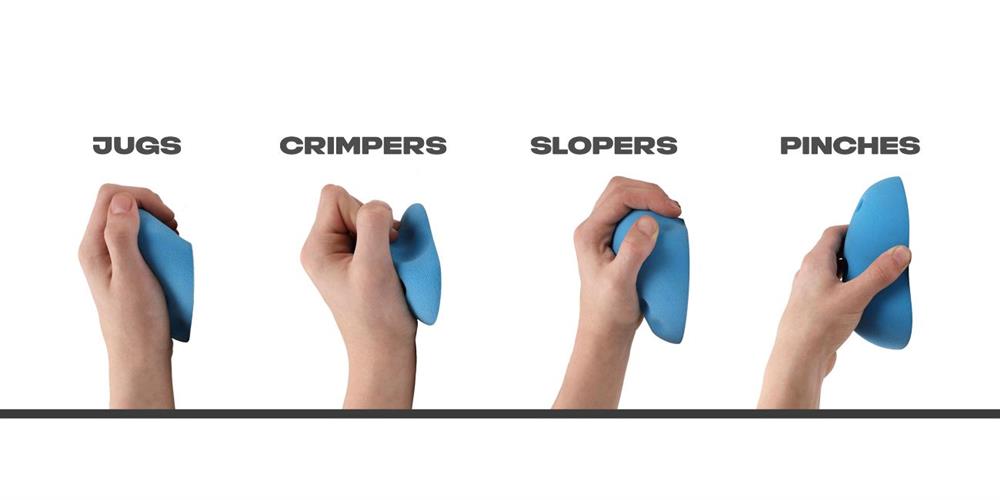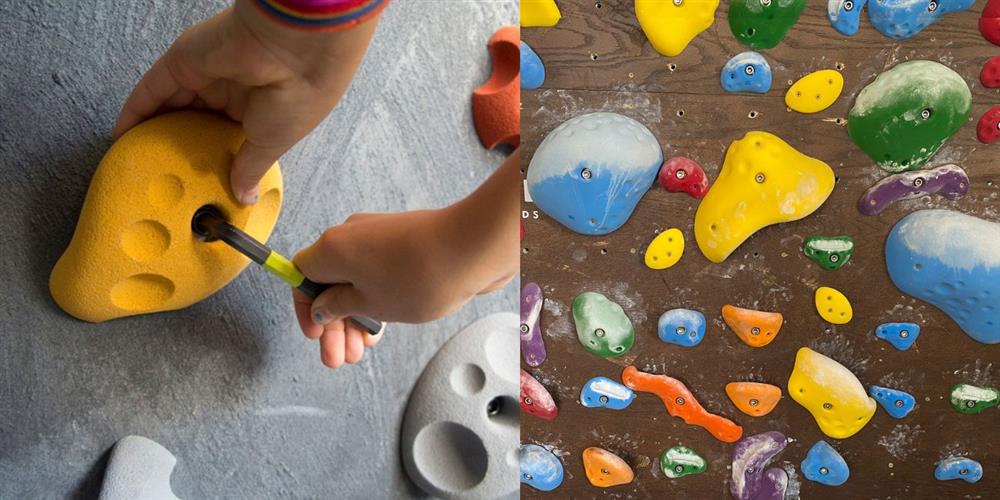Climbing is an adventure that combines strength, skill, and a dash of daring. Understanding climbing training holds is essential for beginners as these holds are the building blocks of the climbing experience, helping beginners hone their skills and build strength. Use this ultimate guide to climbing training holds for beginners to learn about the exciting variety of training holds, their benefits, and how to choose and use them effectively.
Importance of Training Holds for Beginners
Training offers beginners an accessible way to practice climbing in a controlled environment. They allow you to focus on technique, build strength, and gain confidence before tackling more advanced climbs. Understanding the fundamentals of climbing is the best place to start for any eager climber, such as how to properly grip and shift your weight. They serve as stepping stones, preparing you for more complex routes on your indoor climbing wall.
Types of Climbing Holds for Beginners
Many types of climbing holds provide new challenges to help you learn. Include each hold on your indoor climbing wall to familiarize your hands, arms, legs, and feet with their feeling to quickly learn how to scale the wall.
Jugs
Jugs are the go-to holds for beginners due to their large and easy-to-grasp design. These holds resemble handles and provide a secure grip that builds confidence in new climbers. These holds are perfect for practicing basic climbing techniques and developing a solid foundation.
Crimps
Crimps are small holds requiring precise finger placement and strength. These holds challenge climbers to build finger dexterity, making them a great addition to your wall to develop finger strength and controlled movements. Climbing on crimps requires controlled movements and careful weight distribution, enhancing finger control and grip endurance.

Slopers
Slopers are smooth, rounded holds that test beginner’s balance and grip strength. Unlike jugs or crimps, slopers lack sharp edges, requiring climbers to rely on friction and body positioning. These holds encourage climbers to engage their core muscles and improve their balance.
Pinches
Pinches require a squeezing grip, engaging the entire hand in a challenging exercise. These holds demand finger and hand strength, making them essential for building overall hand power. Pockets enhance finger strength and control, helping climbers improve their ability to maintain secure holds on challenging routes.
Benefits of Using Training Holds
Training holds are excellent tools for developing grip strength, a fundamental aspect of climbing. Regularly using various holds enhances finger, hand, and forearm strength, allowing climbers to maintain secure grips on challenging surfaces. Improved grip strength translates to increased climbing ability, enabling climbers to confidently tackle more difficult routes.
Repetitively climbing on holds builds muscular endurance, allowing beginner climbers to sustain effort over longer periods. Improved stamina enables climbers to complete challenging routes without fatigue, enhancing their overall climbing performance.
Training holds also provide a controlled environment for refining climbing techniques. Using different hold types, climbing may focus on foot placement, body positioning, and movement efficiency. Practicing proper technique in training translates to better climbing performance and reduced energy expenditure.
How To Choose the Right Climbing Holds
Choosing the right climbing holds begins with evaluating your current skill level. Beginners should start with larger holds, such as jugs, to build confidence and learn basic techniques.
Intermediate climbers should incorporate a mix of hold types, including crimps and slopers, to challenge their skills and improve versatility. Advanced climbers may focus on smaller, more specialized holds to refine their technique and tackle challenging routes.
Consider the available wall space and setup. Assess your climbing wall’s dimensions to determine the number and arrangement of holds needed. Ensure that you space each hold appropriately to allow for comfortable and safe climbing.
Atomik Climbing Holds offers various holds in numerous shapes and sizes for all skill levels, from American Ninja Warrior courses to aspiring climbers.
Our climbing holds also come in various materials and textures, each offering a unique experience. Smooth holds provide a different challenge than rough-textured ones, requiring climbers to adapt their grip technique. Consider the hold’s material, such as resin or polyurethane, as it affects durability and grip quality.
Training Techniques for Beginners
Setting realistic goals is essential for effective climbing training. Define achievable objectives that align with your skill level and aspirations, such as completing a specific route or improving endurance. Break larger goals into smaller, manageable milestones to track your progress and maintain motivation.
Establish a consistent climbing routine for skill development. Dedicate yourself to a regular climbing practice at a climbing gym or on your home wall.
Incorporate a mix of climbing styles and hold types to challenge different aspects of your abilities. Maintain a balance between climbing sessions and rest days to prevent overexertion and promote recovery.

Safety Precautions for Training Holds
Safety is a priority whether you’re on the ground or holding on to a crimp 20 feet up. Regularly inspecting your climbing training equipment and holds is essential for safety. Check your climbing harnesses, ropes, and belay devices for signs of wear or damage before each session.
Inspect holds for cracks, chips, or loose fastenings and promptly address any issues. Familiarize yourself with the correct use of climbing hardware, such as carabiners and belay devices, to ensure safe and efficient climbing.
Maintaining Climbing Holds
Regular cleaning and care of climbing holds are essential for maintaining their grip and longevity. Use a soft brush or cloth to remove chalk, dirt, and debris from each hold to prevent slipping. Periodically wash the holds with mild soap and water to remove buildup and restore their texture.
Regularly inspect climbing holds for signs of wear and tear, such as cracks, chips, or rounded edges. Replacing damaged holds is crucial for maintaining a safe and effective climbing setup. Remove holds with significant wear, cracks, or other damage that could compromise safety. Choose one of our replacement holds that matches your skill level and training goals and securely install them.
Common Mistakes and How To Avoid Them
Training requires putting your best foot forward and placing your hand in the right position.Overgripping is a common mistake that leads to fatigue and decreased climbing performance. Climbing with excessive grip tension strains muscles and increases the risk of injury.
Practice grip relaxation and controlled movements to conserve energy and improve technique. Focus on efficient weight distribution and foot placement to reduce your reliance on grip strength.
Keep these techniques in mind when climbing the wall.Neglecting these techniques in favor of strength can hinder your climbing progress and lead to inefficiencies. Prioritize proper technique, such as body positioning and footwork, to optimize climbing performance.
Practice movement efficiency and balance to enhance climbing skills and conserve energy. Your form will improve as you climb with more technique in mind. Soon, you will fall into a habit of following proper climbing procedures.
Climbing is a dynamic and rewarding sport that offers physical and mental challenges. Use this ultimate guide to climb training holds for beginners and ascend to new heights. Embracing these principles will lead to a fulfilling and sustainable climbing journey, whether you’re a novice or an experienced climber.




Leave your comment